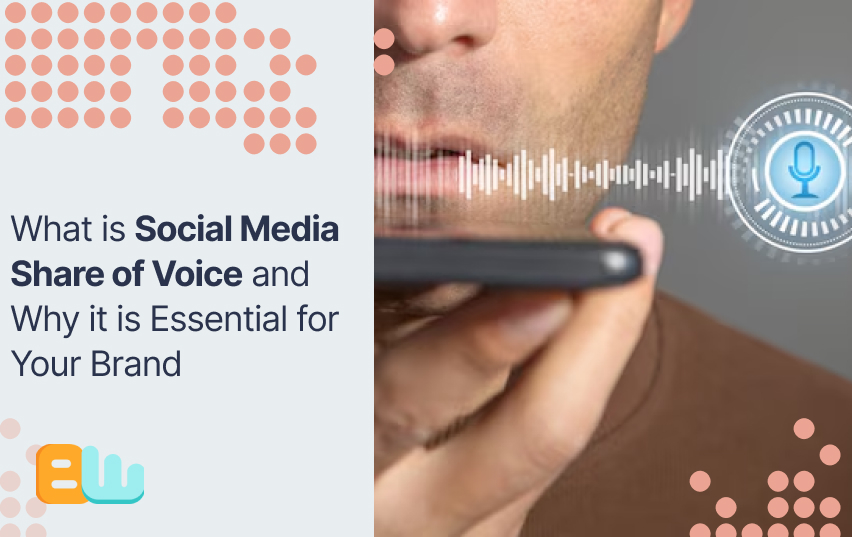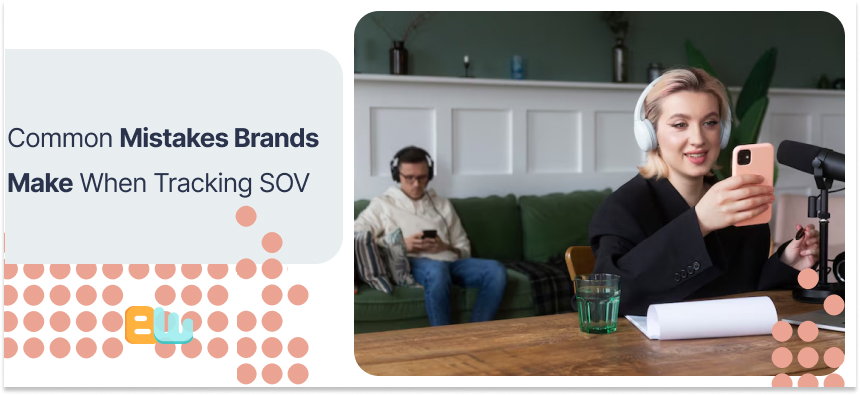
When your customers think about buying similar products, does your brand come to their mind first? These questions draw attention to social media share of voice, an important statistic that many marketers ignore.
Being heard in the crowded market is not only a nice-to-have advantage in today’s digital environment, but it is necessary for life. The competition for attention has never been fiercer, since the typical individual spends 2.5 hours a day on social media, and there are over 4.9 billion users worldwide.
This guide will explain social media share of voice in detail, explain why it will be more important than ever in 2025, and show you how to measure and enhance it to improve your brand’s place in the marketplace. You’ll find practical insights to improve your brand’s voice over rivals, regardless of how you’re currently monitoring your online presence or how you want to improve your strategy.
Understanding Social Media Share of Voice Fundamentals

Compared to your competitors in your niche, social media share of voice (SOV) indicates how many times your brand is mentioned on social media platforms or anywhere online. Simply explained, it’s the amount of social media talk about your brand comparing to your rivals.
Think of it as a digital town square where every brand is trying to be heard. Your share of voice indicates how much of that conversation you own.
How Share of Voice Is Measured Across Social Platforms
Measuring SOV requires tracking mentions of your brand against total industry mentions. The basic formula looks like this:
(Your Brand Mentions ÷ Total Industry Mentions) × 100 = Your Share of Voice %
But it’s not just about raw numbers. Modern SOV measurement considers:
– Brand mentions (tagged and untagged)
– Industry-specific hashtags
– Product category discussions
– Competitor mentions
– Sentiment analysis
Each platform offers different metrics. On Twitter, it might be retweets and replies. On Instagram, comments and saves. On LinkedIn, it could be shares and comments on industry topics.
The key is consistency in your tracking methods across platforms to ensure you’re comparing apples to apples when analyzing your performance over time.
The Difference Between Share of Voice and Share of Market
Share of voice and share of market are sometimes confused by marketers, yet they measure separate parts of your company:
Share of Voice measures your brand’s visibility and presence in conversations.
Share of Market measures your actual sales compared to total industry sales.
Despite being distinct measures, they are tightly connected. Brands with a greater SOV than their market share tend to expand, whereas those with a lower SOV than market share tend to shrink, according to research from the Ehrenberg-Bass Institute.
5 Key Components That Make Up Social Media SOV
1. Volume: The total number of mentions your brand receives across platforms.
2. Reach: How far your brand mentions travel and how many people potentially see them.
3. Sentiment: The emotional tone behind mentions (positive, negative, or neutral).
4. Engagement: How people interact with mentions of your brand through likes, comments, shares.
5. Context: The topics and conversations where your brand appears naturally.
Each component provides different insights. While sentiment indicates how people feel about your brand, volume may indicate awareness. When combined, they create a complete image of your online persona.
Why Social Media Share of Voice Matters in 2025

It is essential to participate in the conversation in the hyperconnected world of today. Let’s look at the reasons why SOV is now more important than ever for brands.
How SOV Directly Impacts Your Brand’s Digital Visibility
The algorithms that power social media platforms prioritize engaging content from sources that users interact with regularly. When your SOV increases, it creates a flywheel effect:
1. Higher SOV means more people see and engage with your content
2. Increased engagement signals relevance to algorithms
3. Algorithms show your content to more users
4. Your visibility expands further
This virtuous cycle can dramatically impact your organic reach. A study by Sprout Social found that brands with above-average SOV in their industry enjoyed 31% higher organic visibility compared to competitors.
For example, Duolingo has leveraged a distinctive brand voice on TikTok to achieve an SOV that far outweighs their market position in the language learning app space, driving massive brand awareness among Gen Z users.
The Connection Between Share of Voice and Consumer Trust
In digital marketing, trust has emerged as the new currency, and SOV is essential to fostering it. You establish yourself as a known presence in your customers’ digital world when they see your brand regularly taking part in relevant discussions.
63% of customers need to hear about a brand three to five times before they believe it, according to the 2023 Edelman Trust Barometer. Your communications will consistently reach customers through several touchpoints if your SOV is powerful.
Moreover, you establish yourself as a thought leader rather than just a salesman when your company actively engages in industry discussions, offering value in addition to selling items. This authentic presence builds credibility that advertising alone cannot achieve.
3 Ways SOV Influences Purchase Decisions Among Audiences
1. Mental Availability: Brands with higher SOV come to mind more easily when consumers are ready to purchase. This “mental availability” translates directly to consideration. According to Byron Sharp’s research, when consumers are making purchases, being at the forefront of their minds frequently matters more than brand differentiation.
2. Social Proof: Customers get strong social validation when they witness others talking about your brand. In 2022, 87% of consumers check online reviews for local businesses, and 72% of respondents said that reading favorable evaluations increases their trust in the company, according to a BrightLocal survey.
3. Decision Simplification: In a society where there are many options, people make decisions by taking mental shortcuts. Even if every other element is the same, choosing a well-known brand (one with a high SOV) is less risky than choosing an unknown one.
Warby Parker is a prime example of this effect; despite being a more recent company than its more established rivals, they have created a reputation for being innovative and socially conscious in this strong industry.
Measuring Your Brand’s Social Media Share of Voice

Now that we understand the importance of SOV, let’s explore how to effectively measure it for your brand.
Top Tools for Tracking Share of Voice Metrics
Several powerful tools can help you track and analyze your SOV across platforms:
1. Brandwatch: Offers comprehensive social listening with advanced sentiment analysis and competitive benchmarking. Best for enterprise-level brands needing deep insights.
2. Sprout Social: Provides accessible SOV tracking with visual competitive comparisons and engagement metrics. Great for mid-sized businesses.
3. Mention: Offers an easy-to-use interface for tracking brand mentions in real-time on social media and the internet. Perfect for smaller groups.
4. Hootsuite: In addition to social media management, Hootsuite Insights offers strong listening capabilities that monitor vibe, mentions, and market trends.
5. Talkwalker: Provides sentiment detection powered by AI in 187 languages and specializes in visual content analysis.
Your budget, team size, and particular requirements will determine which tool is best for you. Try a few before committing because many offer free trials.
Setting Realistic Benchmarks Against Industry Competitors
Effective SOV measurement requires proper context. Follow these steps to establish meaningful benchmarks:
1. Determine your actual rivals: They might not be who you expect. Find out which brands come up in conversations with yours by using social listening.
2. Create your baseline: To determine where you are starting from, monitor your current SOV for a minimum of 30 days.
3. Examine industry averages: The “normal” SOV distributions vary per industry. Leaders may have 30–40% SOV in developed markets, while even 15% may indicate leadership in fragmented marketplaces.
4. Set incremental goals: Rather than aiming for impossible goals, try to raise your SOV by two to three percentage points every quarter.
Remember that context matters—a lower SOV in positive, high-value conversations may be more valuable than a higher SOV in negative or irrelevant discussions.
Which Social Media Platforms Matter Most for Your SOV?
Not all platforms deserve equal attention when measuring SOV. Your focus should depend on:
1. Where your audience engages: B2B companies might focus on LinkedIn and Twitter, while B2C brands might prioritize Instagram and TikTok.
2. Platform influence in your industry: Fashion brands may find Instagram crucial, while tech companies might prioritize Twitter.
3. Content format strengths: If video showcases your products best, platforms like TikTok and YouTube deserve more attention.
4. Conversation relevance: Some industries generate more meaningful discussion on certain platforms.
Pew Research claims that platform demographics differ greatly. For instance, TikTok users tend to be younger, whereas LinkedIn users typically earn more money and have more education.
Examine the locations of your most productive discussions, then adjust your SOV measurement across platforms appropriately.
Strategies to Increase Your Social Media Share of Voice

Now for the actionable part: how to grow your brand’s presence in social conversations.
Creating Content That Sparks Meaningful Conversations
The best strategy to boost SOV is to produce material that promotes conversation and sharing:
1. Ask exciting questions: Information that starts with “How do you handle…” or “What do you think about…” encourages engagement.
2. Take a stand on industry issues: Unlike safe, common topics, expressing a clear viewpoint—even if it is a little controversial—gets greater interaction.
3. Disclose original research: Data-driven insights that are unique to a given location are very citation-worthy and shareable.
4. Create visual conversation starters: Infographics that illustrate surprising facts or challenge assumptions get shared widely.
5. Tell authentic stories: Narrative content that features real customers or employees solving real problems resonates deeply.
With material centered on environmental advocacy that is consistent with their brand values, Patagonia is a prime example of this strategy. Their postings frequently receive thousands of shares and comments, which greatly increases their SOV in the outdoor clothing market.
How Influencer Partnerships Can Amplify Your Voice
Strategic influencer collaborations can dramatically expand your SOV when executed properly:
1. Prioritize relevance over reach: A superstar with millions of generic followers will not generate as much worthwhile conversation as an influencer with 10,000 highly engaged followers in your industry.
2. Give long-term relationships priority: long-term collaborations create more genuine interactions than one-time marketing campaigns.
3. Co-create content: Rather than only delivering your message, involve influencers in the ideation process.
4. Take advantage of micro-moments: Collaborate with influencers to participate in hot discussions in real time when they are relevant to your business.
5. Measure influence on SOV: Track mention volume before, during, and after influencer campaigns.
Despite spending less on traditional advertising, Glossier has mastered this strategy by establishing relationships with micro-influencers who really like their products. This has led to genuine conversations that have helped the brand retain an outsized SOV in the cosmetics industry.
Leveraging Trending Topics Without Compromising Brand Values
When done carefully, the strategy of matching your material to popular subjects—can greatly increase SOV:
1. Construct a structure for responses: Establish rules for determining which trends fit your brand and which don’t.
2. Real-time trend monitoring: To spot new discussions, use resources such as BuzzSumo, Google Trends, or Twitter’s trending topics.
3. Incorporate real value: Don’t just point out a trend; offer a distinct viewpoint or useful details about it.
4. Move quickly but carefully: The window for relevance is often short, but rushing can lead to tone-deaf content.
5. Pay attention to related discussions: look for popular subjects that logically relate to your area of expertise.
Common Mistakes Brands Make When Tracking SOV

Avoid these pitfalls to ensure your SOV measurement delivers actionable insights.
Why Volume Alone Doesn’t Tell the Complete Story
When evaluating SOV, many brands make the crucial mistake of concentrating only on mention volume:
1. Quality is more important than quantity: 100 mentions from prospective clients are worth more than 1,000 from unrelated audiences.
2. Context determines value: Mentions during purchase consideration discussions carry more weight than casual references.
3. Amplification varies: Some mentions reach thousands of people, while others barely reach anyone.
4. Source credibility impacts influence: A mention from an industry expert carries more weight than random accounts.
5. Conversation clusters reveal insights: Understanding which topics drive mentions reveals opportunities for content strategy.
Instead of just tracking total mentions, segment your SOV analysis by conversation type, audience value, and potential impact on business objectives.
Ignoring Sentiment Analysis in Share of Voice Metrics
A high SOV consisting of negative mentions can be worse than no mentions at all. Yet many brands overlook sentiment when measuring their social presence:
1. Negative mentions can damage reputation: High SOV with poor sentiment often indicates a brand crisis.
2. Sentiment trends reveal emerging issues: A gradual shift from positive to neutral mentions might signal weakening brand affinity.
3. Competitive sentiment comparison provides context: Your 30% SOV looks different if competitors have 90% positive sentiment and you have 50%.
4. Sentiment varies by topic: Your brand might have positive sentiment regarding product quality but negative sentiment about customer service.
5. Regional and demographic sentiment differences matter: Overall positive sentiment might mask problems with specific audience segments.
United Airlines learned this lesson during their 2017 passenger removal incident—they briefly achieved their highest-ever SOV, but with overwhelmingly negative sentiment that damaged their brand.
4 Ways to Avoid Misinterpreting Your SOV Data
1. Compare similar time periods: Seasonal variations can dramatically impact SOV. Always compare year-over-year or month-over-month data.
2. Account for marketing activities: Your campaign launches will temporarily spike SOV. Track baseline conversation separately from campaign-driven mentions.
3. Normalize for industry events: Trade shows, product launch seasons, or industry crises affect all competitors. Adjust expectations accordingly.
4. Consider platform algorithm changes: Updates to social platforms can suddenly change visibility. Track these changes to explain unexpected SOV shifts.
Without these contextual factors, SOV data can lead to incorrect conclusions and strategy adjustments that don’t address real opportunities or problems.
Turning Share of Voice Insights Into Strategic Action

Measurement without action is pointless. Here’s how to translate SOV insights into strategic advantages.
Developing Content Strategies Based on SOV Analysis
Your SOV data contains valuable clues for content strategy development:
1. Identify conversation gaps: Topics where competitors dominate the conversation represent opportunities for your brand to contribute.
2. Analyze high-performing content: Look for patterns in the content that generates the most meaningful mentions.
3. Map customer journey conversations: Determine which topics arise during awareness, consideration, and decision stages.
4. Identify your unique conversational territory: Find intersection points between topics your audience cares about and areas where your brand has credibility.
5. Prioritize content types by engagement patterns: If video mentions generate more engagement than text, adjust your content mix accordingly.
HubSpot exemplifies this approach by using SOV analysis to identify emerging marketing topics, then creating comprehensive resources before competitors, establishing themselves as the definitive voice on new trends.
When to Pivot Your Messaging Based on Voice Metrics
SOV data provides early warning signals for needed messaging adjustments:
1. Declining engagement with key messages: When once-effective messaging stops generating conversation, it’s time to refresh.
2. Competitor message resonance: If competitors suddenly gain SOV with new messaging angles, investigate what’s resonating.
3. Sentiment shifts around specific claims: When previously positive reception to certain claims turns neutral or negative, reconsider those messages.
4. Conversation topic evolution: As industry discussions evolve, messaging must adapt to remain relevant.
5. Audience language changes: The specific words and phrases your audience uses to discuss your category will evolve over time.
Building Long-Term Brand Authority Through Consistent SOV
Sustainable SOV growth builds compounding returns over time:
1. Develop a distinct brand voice: Consistency in tone, perspective, and values makes your contributions immediately recognizable.
2. Create ongoing conversation series: Regular features, hashtags, or discussions that your brand hosts establish ownership of specific topics.
3. Systematically address conversation white space: Create a content calendar that regularly addresses underserved topics in your industry.
4. Invest in thought leadership development: Position key team members as individual voices within industry conversations.
The Future of Social Media Share of Voice

The landscape for SOV measurement and strategy is evolving rapidly. Here’s what to prepare for.
How AI Is Changing SOV Measurement and Analysis
Artificial intelligence is transforming how brands understand their share of voice:
1. Advanced sentiment analysis: AI can now detect subtle emotional nuances, sarcasm, and cultural context in mentions.
2. Predictive SOV modeling: Machine learning algorithms can forecast how specific content or campaigns might impact your future SOV.
3. Automated competitive intelligence: AI tools can identify emerging competitors in your conversation space before they become obvious threats.
4. Visual and audio content analysis: New AI capabilities can track mentions in images, videos, and audio content like podcasts.
Emerging Platforms That Will Impact Your Brand’s Voice
The social landscape continues to evolve, with new platforms changing how SOV should be measured:
1. Audio social spaces: Platforms like Twitter Spaces and Clubhouse represent new frontiers for brand conversations.
2. Niche communities: Specialized platforms like Discord servers and Mighty Networks host valuable vertical-specific discussions.
3. Augmented reality platforms: As AR becomes mainstream, brand mentions in these spaces will grow in importance.
4. Private messaging channels: The shift toward private communication changes how brands must think about conversation influence.
5. Creator economies: Platforms that enable direct creator monetization create new dynamics for brand partnerships and mentions.
Brands need flexible SOV measurement frameworks that can adapt as these emerging channels gain importance in their industries.
Preparing Your Brand for Voice-First Social Media Landscape
Voice technology is reshaping how consumers discover and discuss brands:
1. Make your site voice search-friendly: Voice searches are not the same as typed searches.
2. Create sonic branding components: In audio-first settings, distinctive sounds and audio signatures make brands stand out.
3. Create voice-appropriate content: Information structured for voice assistant delivery differs from traditional social content.
4. Monitor voice-based mentions: New tools are emerging to track brand mentions in podcasts, voice apps, and audio platforms.
5. Experiment with voice interaction: Branded skills for voice assistants can create new conversation opportunities.
Brands that prepare for this voice-first future will maintain and grow their SOV as consumer behavior continues to evolve.
Conclusion: Making Your Brand’s Voice Count
Being heard is more important than ever in the chaotic digital economy of today. Social media share of voice can measure the relevance, influence, and development potential of your business.
You may create long-term competitive advantage by knowing what motivates significant conversations about your business, measuring those conversations, and trying to increase your visibility in the most important talks.
Keep in mind that SOV is about stating things that are worth repeating, not about shouting louder than everyone else. Your share of voice will naturally expand as you add value to the discussions that your audience finds important. This strategy will lead to greater exposure, trust, and eventually, better business outcomes.
What discussion should your brand be spearheading in your industry right now? Your first step to a larger share of voice is the response to that question.
#SocialMediaStrategy #ShareOfVoice
